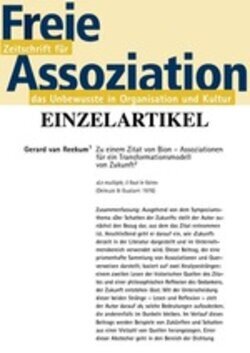24 Seiten, PDF-E-Book
Erschienen: Juni 2005
Bestell-Nr.: 21048
abonnieren
Gerard Van Reekum
Zu einem Zitat von Bion - Assoziationen für ein Transformationsmodell von Zukunft (PDF)
Freie Assoziation 2005, 8(2), 23-46
Sofortdownload
Dies ist ein E-Book. Unsere E-Books sind mit einem personalisierten Wasserzeichen versehen,
jedoch frei von weiteren technischen Schutzmaßnahmen (»DRM«).
Erfahren Sie hier mehr zu den Datei-Formaten.
Ausgehend von dem Symposiumsthema »Der Schatten der Zukunft« stellt der Autor zunächst den Bezug dar, aus dem das Zitat entnommen ist. Anschließend geht er darauf ein, wie ›Zukunft‹ derzeit in der Literatur dargestellt und im Unternehmensbereich verwendet wird. Dieser Beitrag, der eine prismenhafte Sammlung von Assoziationen und Querverweisen darstellt, basiert auf zwei Analysesträngen: einem zweiten Lesen der historischen Quellen des Zitates und einer philosophischen Reflexion des Gedankens, der Zukunft entstehen lässt. Mit der Unterscheidung dieser beiden Stränge – Lesen und Reflexion – zielt der Autor darauf ab, solche Bedeutungen aufzudecken, die anderenfalls im Dunkeln bleiben. Im Verlauf dieses Beitrags werden Beispiele von Zukünften und Schatten aus einer Vielzahl von Quellen herangezogen. Einer dieser Abstecher geht in den Bereich der Dichtung und auf solche Werke wie Coetzees ›Elizabeth Costello‹ und Shakespeares ›Hamlet‹ ein. Vor dem Hintergrund einer Rollenanalyse-Vignette und eines Beispiels aus der Unternehmensberatung wird die Praxis der Voraussage als eine Strategie verstanden, die Zukunft von den Erfahrungen der Vergangenheit und Gegenwart abspaltet. Dem phallischen Bild der ›Implementierung‹ werden dynamischere Veränderungsstrategien gegenübergestellt, die auf »best practices« und einem fortschreitenden Lernen basieren. Im Rückgriff auf die Epistemologie des 20. Jahrhunderts und derzeitige Theorien des Bewusstseins stellt der Autor abschließend einige Überlegungen dar, die den Schluss nahe legen, dass Bion das psychoanalytische Denken aus dem Strukturalismus in den Post-Strukturalismus geführt hat. Bions Modell von Zukunft wird als wirklich transformativ, logisch unabhängig und immanent mannigfaltig dargestellt.
Abstract:
Following the theme of the symposium (›the shadow of the future‹), the author presents a comparative reading of the context from which the quotation is taken, before going back over ›future‹ as it is currently portrayed in literature and utilized in business. This paper, covering a prismatic collection of associations and references, is composed of two strands of analysis: a second reading of the historical evidence for the quote, and a philosophical reflection on the thought that creates future. By distinguishing these two (reading and reflection), the author aspires to expose meanings that otherwise may remain obscured. Over the course of the paper, working examples of futures and shadows are drawn from a variety of sources. One of the detours undertaken is into the realm of fiction, borrowing from works as Coetzee’s ›Elizabeth Costello‹ and Shakespeare’s ›Hamlet‹. Building on a role analysis vignette and examples from business consulting, the practice of forecasting is understood as a strategy to split off future from past and present experiences. The phallic image of ›implementation‹ is contrasted with more dynamic change strategies based on best practices and progressive learning. Finally, finding support in twentieth century epistemology and contemporary theories of consciousness, the author considers Bion as having guided psychoanalytic thinking from structuralism into post-structuralism. Bion’s model for future is presented as truly transformational, logically independent from the present, and immanently manifold.
Abstract:
Following the theme of the symposium (›the shadow of the future‹), the author presents a comparative reading of the context from which the quotation is taken, before going back over ›future‹ as it is currently portrayed in literature and utilized in business. This paper, covering a prismatic collection of associations and references, is composed of two strands of analysis: a second reading of the historical evidence for the quote, and a philosophical reflection on the thought that creates future. By distinguishing these two (reading and reflection), the author aspires to expose meanings that otherwise may remain obscured. Over the course of the paper, working examples of futures and shadows are drawn from a variety of sources. One of the detours undertaken is into the realm of fiction, borrowing from works as Coetzee’s ›Elizabeth Costello‹ and Shakespeare’s ›Hamlet‹. Building on a role analysis vignette and examples from business consulting, the practice of forecasting is understood as a strategy to split off future from past and present experiences. The phallic image of ›implementation‹ is contrasted with more dynamic change strategies based on best practices and progressive learning. Finally, finding support in twentieth century epistemology and contemporary theories of consciousness, the author considers Bion as having guided psychoanalytic thinking from structuralism into post-structuralism. Bion’s model for future is presented as truly transformational, logically independent from the present, and immanently manifold.
Dieter OhlmeierS. 7–22Die Psychoanalyse in Deutschland im Spiegel ihrer Geschichte - einige Überlegungen zur Psychoanalyse in Gegenwart und Zukunft (PDF)
Freie Assoziation 2005, 8(2), 7-22Gerard Van ReekumS. 23–46Zu einem Zitat von Bion - Assoziationen für ein Transformationsmodell von Zukunft (PDF)
Freie Assoziation 2005, 8(2), 23-46Susan LongS. 47–62Systeme unbewusster Vereinbarungen: Schatten durch die Zeit (PDF)
Freie Assoziation 2005, 8(2), 47-62Burkard SieversS. 63–87»Die Vergangenheit rückwärts vor sich her schieben« - Eine sozioanalytische Sicht der Beziehung von Vergangenheit, Gegenwart und Zukunft in Organisationen (PDF)
Freie Assoziation 2005, 8(2), 63-87James KrantzS. 89–103Einige Gedanken über Reflexion in Organisationen (PDF)
Freie Assoziation 2005, 8(2), 89-103
Freie Assoziation 2005, 8(2), 7-22Gerard Van ReekumS. 23–46Zu einem Zitat von Bion - Assoziationen für ein Transformationsmodell von Zukunft (PDF)
Freie Assoziation 2005, 8(2), 23-46Susan LongS. 47–62Systeme unbewusster Vereinbarungen: Schatten durch die Zeit (PDF)
Freie Assoziation 2005, 8(2), 47-62Burkard SieversS. 63–87»Die Vergangenheit rückwärts vor sich her schieben« - Eine sozioanalytische Sicht der Beziehung von Vergangenheit, Gegenwart und Zukunft in Organisationen (PDF)
Freie Assoziation 2005, 8(2), 63-87James KrantzS. 89–103Einige Gedanken über Reflexion in Organisationen (PDF)
Freie Assoziation 2005, 8(2), 89-103

